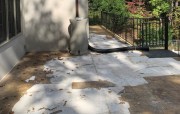Having a plan B
When all else fails, or the construction budget and schedule do not allow for the above listed preemptive strikes to be used, you still have options to repair a wet or disturbed building pad. If the soil subgrade is exposed and the aggregate subbase has not been placed, the typical methods include discing and aerating, undercutting and replacement, or chemical stabilization. If the aggregate base course has been placed, there are a few techniques that have been successfully implemented to save the pad without completely undercutting and starting over. If wet weather is the culprit, it may be possible to excavate a series of shallow sump holes and pump the water out of the aggregate base before it has a chance to soak into the soil subgrade. The sump holes usually are excavated adjacent to any interior column pads and at midpoints between the columns with the sump holes at maximum 20-foot spacings. This can be labor intensive, but if done immediately after a large rain event, it can get enough water out of the pad to save the sub-base.
Other techniques of drying the aggregate, such as windrowing and aerating the stone, can be considered if the aggregate subbase is thick enough but this could result in excessive mixing with the underlying soil subgrade. Sometimes the wet aggregate subbase and the uppermost soil subgrade can be mixed together and chemically stabilized in-place to avoid wasting the wet stone. This can create a firm subgrade but often at the loss of the aggregate subbase’s ability to provide drainage, cushion, and a capillary break. It also becomes very critical that the stabilized material be accurately fine graded to avoid variations in slab thickness.
If there is a light to moderate rain event, it is good practice to dig several shallow test holes with a shovel or hand auger to determine the wetness of the aggregate subbase and soil subgrade. Many times the rainwater has only wetted the stone and the upper fraction of an inch of the soil subgrade. Although this amount of moisture may lead to excessive rutting if the concrete is directly end-dumped with concrete truck traffic on the subbase, it may be possible to use a pump truck and successfully complete the slab pour by keeping traffic off of the pad.
Hopefully these techniques can provide food for thought for your next large floor slab preparation. It is important to discuss your game plan with the project geotechnical engineer, as well as the design and construction teams, to confirm that the planned approach is consistent with the project constraints.
— Ronald S. Lech, PE, is a project geotechnical engineer with H.C. Nutting, a Terracon Co., in Cincinnati, Ohio. Lech has 15 years experience managing geotechnical studies, construction administration, and construction testing and inspection for commercial and public sector construction projects. He can be reached at 513-321-5816 or rslech@terracon.com.



